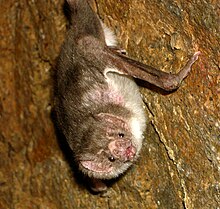| Leaf-nosed bats | |
|---|---|

| |
| Artibeus sp. | |
| Scientific classification | |
| Domain: | Eukaryota |
| Kingdom: | Animalia |
| Phylum: | Chordata |
| Class: | Mammalia |
| Order: | Chiroptera |
| Superfamily: | Noctilionoidea |
| Family: | Phyllostomidae Gray, 1825 |
| Type genus | |
| Phyllostomus Lacépède, 1799
| |
| Subfamilies | |
|
Carolliinae | |
The New World leaf-nosed bats (Phyllostomidae)[1] are bats found from southern North America to South America, specifically from the Southwest United States to northern Argentina. They are ecologically the most varied and diverse family within the order Chiroptera. Most species are insectivorous, but the phyllostomid bats include within their number true predatory species and frugivores (subfamily Stenodermatinae and Carolliinae). For example, the spectral bat (Vampyrum spectrum), the largest bat in the Americas, eats vertebrate prey, including small, dove-sized birds. Members of this family have evolved to use food groups such as fruit, nectar, pollen, insects, frogs, other bats, and small vertebrates, and in the case of the vampire bats, even blood.[2]
Both the scientific and common names derive from their often large, lance-shaped noses, greatly reduced in some of the nectar- and pollen-feeders. Because these bats echolocate nasally, this "nose-leaf" is thought to serve some role in modifying and directing the echolocation call. Similar nose leaves are found in some other groups of bats, most notably the Old World leaf-nosed bats.

New World leaf-nosed bats are usually brown, grey, or black, although five species are white. They range in size from 4.0 to 13.5 cm (1.6 to 5.3 in) in head-body length, and can weigh from 7 to 200 g (0.25 to 7.05 oz). Most roost in fairly small groups within caves, animal burrows, or hollow trees, although some species aggregate in colonies of several hundred individuals.[3] They do not hibernate, although some species have been reported to aestivate.[4][5]
- ^ Fleming, Theodore; Dávalos, Liliana; Mello, Marco (2020). Phyllostomid Bats: A Unique Mammalian Radiation (1st ed.). Chicago: University of Chicago Press. p. 512. ISBN 978-0-226-69612-6. Retrieved 4 November 2020.
- ^ Cite error: The named reference
Camachowas invoked but never defined (see the help page). - ^ Garbino, Guilherme S. T.; Tavares, Valéria da Cunha (2018). "Roosting ecology of Stenodermatinae bats (Phyllostomidae): evolution of foliage roosting and correlated phenotypes". Mammal Review. 48 (2): 75–89. doi:10.1111/mam.12114. ISSN 1365-2907. S2CID 89929161.
- ^ Macdonald, D., ed. (1984). The Encyclopedia of Mammals. New York: Facts on File. pp. 805. ISBN 978-0-87196-871-5.
- ^ Wetterer, Andrea L.; et al. (2000). "Phylogeny of Phyllostomid Bats (Mammalia: Chiroptera): Data from Diverse Morphological Systems, Sex Chromosomes, and Restriction Sites". Bulletin of the American Museum of Natural History. 248 (1): 1–200. doi:10.1206/0003-0090(2000)248<0001:POPBMC>2.0.CO;2. hdl:2246/1595.